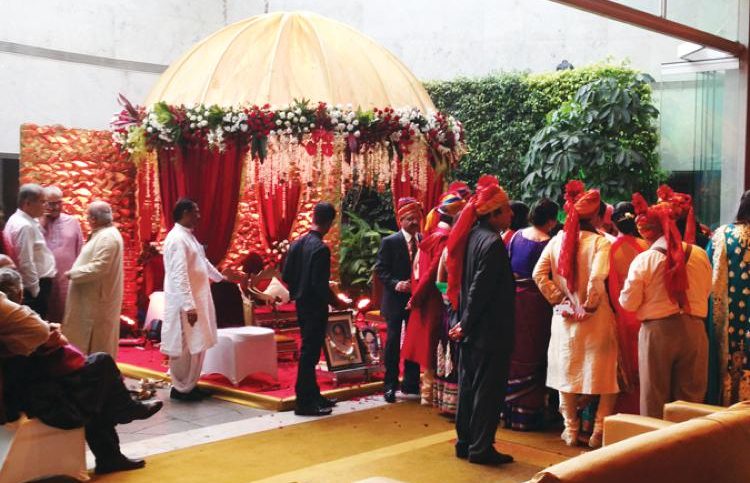by Lujain F. Al-Mulla
I send a reminder: “Don’t forget the wedding invites, Nora!”
I peek into my purse one final time and, sure enough, my passport is still inside — same as it had been the last five times I checked.
Nora sends back: “They’re in my suitcase. Don’t worry.”
A honk outside startles me. My ride is here. I rush downstairs and halfway down I realize I’d left my suitcase in my room.
“Scatterbrain!” I huff and rush back upstairs.
At the airport counters, I meet with my co-workers/makeshift travel-mates and we share big smiles.
“Can you believe that this time tomorrow, we’ll be at an Indian wedding?” I squeal.
“Can you believe we’ll be in India — period!” Shahd corrects me.
We check in our four bags and head to our gate. Khalid holds out his phone and takes a quadroselfie of us before boarding the aeroplane – a selfie that involves four subjects, including the person snapping the photograph. It’ll catch on, I tell you! None of us have ever visited India before and I fidget with excitement throughout the plane ride.
After stopping in Doha, we are on our way to Mumbai, or Bombay as it is still often called. It’s 3a.m. local time when we touch ground. We disembark the plane into a jetway, and are welcomed by a lush extension of carpet. This carpet, we come to realize, is bedecked upon the entire distance from the gates to the passport control desks. Gilded with a vivacious paisley pattern of bright orange and deep purple, the soft carpet gives with every weary step, thoughtful of tired red-eye travelers.
Lucky for us, this terminal had just opened two weeks prior and is absolutely exalting. Besides the hospitable carpeting, we are met by walls covered in a blend of contemporary artwork and ancient artefacts: murals of printed circuit boards studded with computer chips and electronic thingamabobs, followed by carved statues of Indian deities like those one might find in a Jain temple. At the passport control desks we behold yet another colossal piece of art; the white wall of this hall is beautifully lit through recesses, quite dreamlike – having had no sleep, I fight the urge to slip into a dream, a trance, hypnotized. Mumbai had curated a museum of an airport that is in itself enough reason to visit this city. We collect our luggage and head out.
Our hotel is a minute’s drive away from the terminal. As soon as we check in and roll our bags into our bedrooms, we get ready for bed. I yawn in between oohs and ahs at the luxury of the place. We have a big day ahead of us and need all the rest we can get.
We wake up at 2p.m. and get dressed and ready for day one of wedding festivities: the Ring Ceremony and Sangeet. “I can’t wait to see Aanchal”, I tell Nora as I outline my eyes with black kohl and she slips her head through the neck of her sparkling dress. We call the others; they’re ready, we’re ready, I adjust my aubergine gown and makeup one last time and we head to the elevators. I pull out my phone and we take another quadroselfie of us all dressed up.
A hotel car drives us to the venue. The streets of Mumbai are packed with jostling cars and auto rickshaws. Lane markings are non-existent, and taxis and lorries are painted in every hue of a color palette as if smeared in war paint, ready to battle their way through the crowd. The words “Horn OK Please” are stencilled onto bumpers everywhere and tailgating vehicles oblige; honking is encouraged, nay, celebrated in these streets! Car horns are the shofars of chauffeurs! The noise is incessant. Vehicles stack up at traffic lights as tightly as tiles in a game of Tetris. The traffic is dizzying. The roads are lined with shops and crumbling blocks of flats. Flats are then cut off by a myriad of rickety shanty houses interlocking, one over the other, like colorful Lego blocks; a network of ladders criss-crosses the façade. We gape —amazed and disheartened.
We finally arrive at the clubhouse. Our eyes dilate and feast on luxury once more. Trees outside are ornamented with lights and the entrance is framed with an arch of dangling white flowers. Inside: lights, food, music, color and more color. Multi-colored saris and kurta pyjamas diffuse about the room and I feel I’ve entered a kaleidoscope. The room is set up like a musical concert with a stage. We find the bride sitting in the front row.
“You guys made it!” she shrieks and hugs. We meet the bridegroom — a tall soft-spoken gentleman in a prim sherwani. I’m instantly envious of the embroidered sari she is in — green and blue and bejewelled. A pearl-studded headpiece hangs on her forehead. Her henna is like none I’ve seen before; her forearms are a canvas depicting an Indian bride and groom surrounded by auburn blooming vines — a sacred crawling garden fenced by stacks of bangles.
The music is riveting. Three singers alternate through the night backed by a lively band. Families dance. Food goes around. A veil of mirth and incense blankets the room. At the end of the night, we’re spent.
We return to the hotel, change out of our regalia and recount all we’d seen over a cup of Darjeeling tea. We share photos with family and friends back home, then call it a night.
The next day, we have breakfast together and head out to explore the city a bit before day two of the wedding. We return late in the afternoon bearing shopping bags and sore feet. Nora and I alternate between ironing our party-wear and taking a rejuvenating shower. We repeat the routine of the day before; this time, I apply lighter hues of makeup to match the gold and aqua blue of my dress. We meet Shahd and Khalid by the elevators where, having worn a suit and tie the day before, today, Khalid is in a crisp dishdasha and shmagh; we chuckle at the thought of the stares we are about to get. Day two consists of the wedding and reception, and is held at our hotel ballroom. We take our now habitual quadroselfie and head down. Very conscious of the attention we’re getting, we glide through the lobby, all smiles, and are stopped dead in our tracks as soon as we reach the ballroom entrance. We’re greeted by yet another plethora of flowers. At the far end of the ballroom, we see the bride and groom’s mandapa — a red, flower-adorned canopy under which sit Aanchal and her beau. The canopy shelters them under a glass dome that lets in lustrous sunlight; its windows are cracked open and echoes of chirping birds reverberate from wall to wall. I am filled with veneration.
We sit ourselves in the second row of seats, scooching to get a better view of the bride. Her sari is scarlet red and tinselled in glittering threads and sequences. A piece of jewelry hangs from her ear to her nose, hooking on a golden hoop. Red and white choora bangles are stacked up her arms; according to tradition, she must wear these for 40 days. Kaliras hang from her wrists — large heavy masses of golden jewelry that look very uncomfortable but lavish. A veil rests on her head and, across her shoulder, a sash of roses; she looks majestic. Hindu rituals carried out by a mantra-chanting man of religion bind the blushing pair together. A shehnai — an Indian oboe-like instrument — can be heard in the background. People are walking into the ballroom and out to the buffet as all this takes place. We try some of the food ourselves. For the first time, I try what I come to discover is called panipuri, a pleasantly sweet yet spicy surprise to the taste buds.
The newly-weds leave the ballroom sprinkled with flowers and holy water. We hang about the ballroom a little longer and mingle with the guests, many of whom, we learn, are residents of Kuwait — Aanchal’s side of the family. Others, natives of Mumbai, very thoughtfully let us in on the best places to visit during the remainder of our stay in the city. We notice that the guest chairs are now being turned to face the other end of the ballroom; their covers are replaced and a stage is revealed, decked with yet another floral array of pale pink and white. Men carrying trays disperse among the seated crowd, tempting guests with more Indian finger food. Everything is spicy and delicious. Later, the bride, groom and their family ascend this stage and the reception begins. Aanchal has changed into another decorated sari, pink, this time, and no less beautiful than her former gowns. Guests line up to walk across the stage, say their final congratulations to the proud family and take photographs. It gets crowded so we settle for a wave to Aanchal from afar, sending a flying kiss or two before leaving the ballroom and heading back to our rooms.
As I lie on the hotel bed, knackered and uncoiling, I think how lucky I am to have been given the opportunity to attend an authentic Hindu wedding, to have shared it with people dear to my heart. What I love most about Mumbai is its people, friendliness and hospitality seem to come so naturally to locals of this land. What the rest of our stay has in store for us, I can barely wait to feast my senses on.











